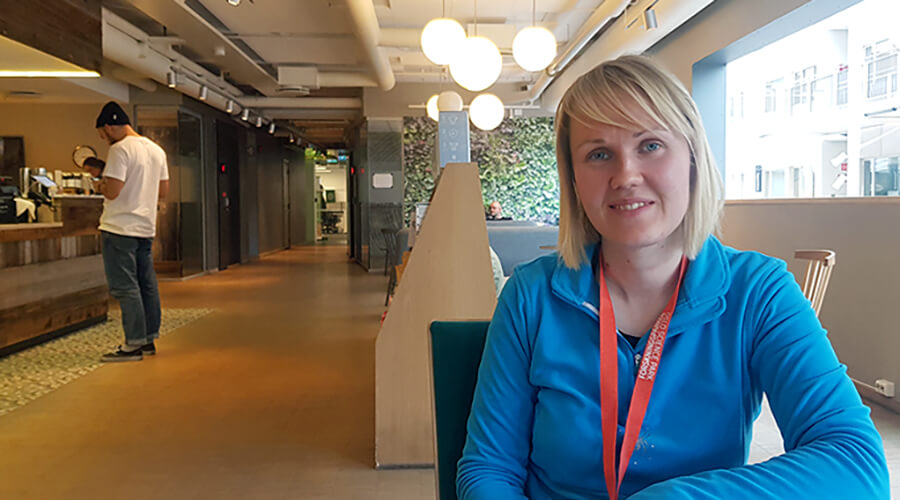Oslo Science Park News interviewed our group leader Emma about how she first got into science, what it’s like working at NCMM and her thoughts about CRISPR technology. You can read the full article here in Norwegian.
Repairing damaged genetic material
Emma came to Oslo in January 2019 to lead a group for Precision Medicine at NCMM (Centre for Molecular Medicine Norway). The group is interested in diseases such as immunodeficiency, rare blood cancers and other troublesome autoimmune diseases which are mainly caused by congenital defects in the DNA. The Haapaniemi group’s research involves locating the defect in the DNA and repairing it using “programmable gene scissors”.
Studying medicine at a young age
Emma talks about how she first got interested in medicine at a young age and pursued her career:
In my teens, I opened my eyes to research. I was a fairly ordinary child, but had a relatively unusual hobby. How I found books on hematology as a 10-year-old? I went to the library. My teacher and parents didn't like this hobby and they asked me to stop, but I continued anyway. Neither of my parents has a higher education. I'm the oldest of four siblings and the only doctor in the family.
Some children want to become professional footballers or good at cross-country skiing. For me, it was medicine. Of course, it would be great if parents - and society as a whole - encouraged children who are interested in, for example, medicine or the weather, as much as they support young cross-country skiing stars. If you come from an ordinary family and have academic interests as a child, it can feel very lonely.
After medical training and a doctorate in Helsinki, I envisioned continuing to work in the USA. But I was offered research in Jussi Taipale's group at the Karolinska Institutet in Stockholm. This group had done several pioneering technological works already, so I chose Karolinska. There I worked with gene editing - CRISPR-Cas technology, particularly with how the cell reacts to it, and how to make the method safer and more effective in patient treatment.Emma Haapaniemi
What's it like working at the Oslo Science Park?
At NCMM, Emma leads an international research group consisting of four staff: herself, Anna from Ukraine, Ingrid from Finland, and Zhuokun from China. In the future, the goal is to recruit more staff and grow the team with postdocs and a lab manager. The group also welcomes students.
Additionally, Emma wishes for more Norwegian doctors and researchers to join NCMM for further clinical insights into projects and to better understand how the Norwegian system works.
It's crucial that doctors become familiar with molecular biology research, since future specialist health services will use molecular disease profiling to provide the patient with targeted treatment. In addition, new scientific discoveries will be moved more quickly to the clinic when the doctors are part of a research group.
I originally wished to have both a clinic and research here. I had a plan to specialize in paediatrics, but it's quite demanding to try to start a new type of gene therapy treatment and specialize at the same time. Now I'm cutting out the clinic and focusing on the work here in the Research Park. I hope to return to clinical work when my new group is fully established, as it's still important to keep in touch with the hospital.Emma Haapaniemi
Emma has perfected her Swedish during her period working at the Karolinska Institutet in Sweden, and together with her English skills she is doing excellently after just 3 months in Norway.
Her working day starts around 9am and she goes home between 7-8pm almost every evening. Her husband is studying Economics in London, so meeting together in London sometimes brings a welcome change in her busy life.
Making the CRISPR technology available and affordable
Emma talks further about the technology she works with and its current challenges with availability and affordability.
The aim is to be able to develop a tool so that many patients with various hereditary diseases can be treated. The tool must also be affordable and so easy to use that each individual hospital can use it themselves. The challenge with new therapies for rare diseases is the cost - sometimes the price can reach NOK 10 million for a treatment. Most societies cannot afford this, and the patients, who are often children, remain untreated and die.
If the CRISPR technology is to be made available to patients sometime in the future, large investments will be required due to the thorough clinical trials that are required, as well as the processes for approvals by the health authorities. Then it is likely that you will have to start a business and raise capital to make this happen.
I think the many small businesses here in the Research Park are exciting, and I would like to learn more about how they work. The conventional CRISPR method is already being used in clinical trials in China and the USA, mainly in immunotherapy against cancer. We've made significant changes to the method and are looking at the possibility of using an adapted system in clinical treatment. We will first try to implement this locally in the Nordic countries.
This technology can also be used on fish, animals and plants, so I'm open to collaborating with other fields.Emma Haapaniemi
